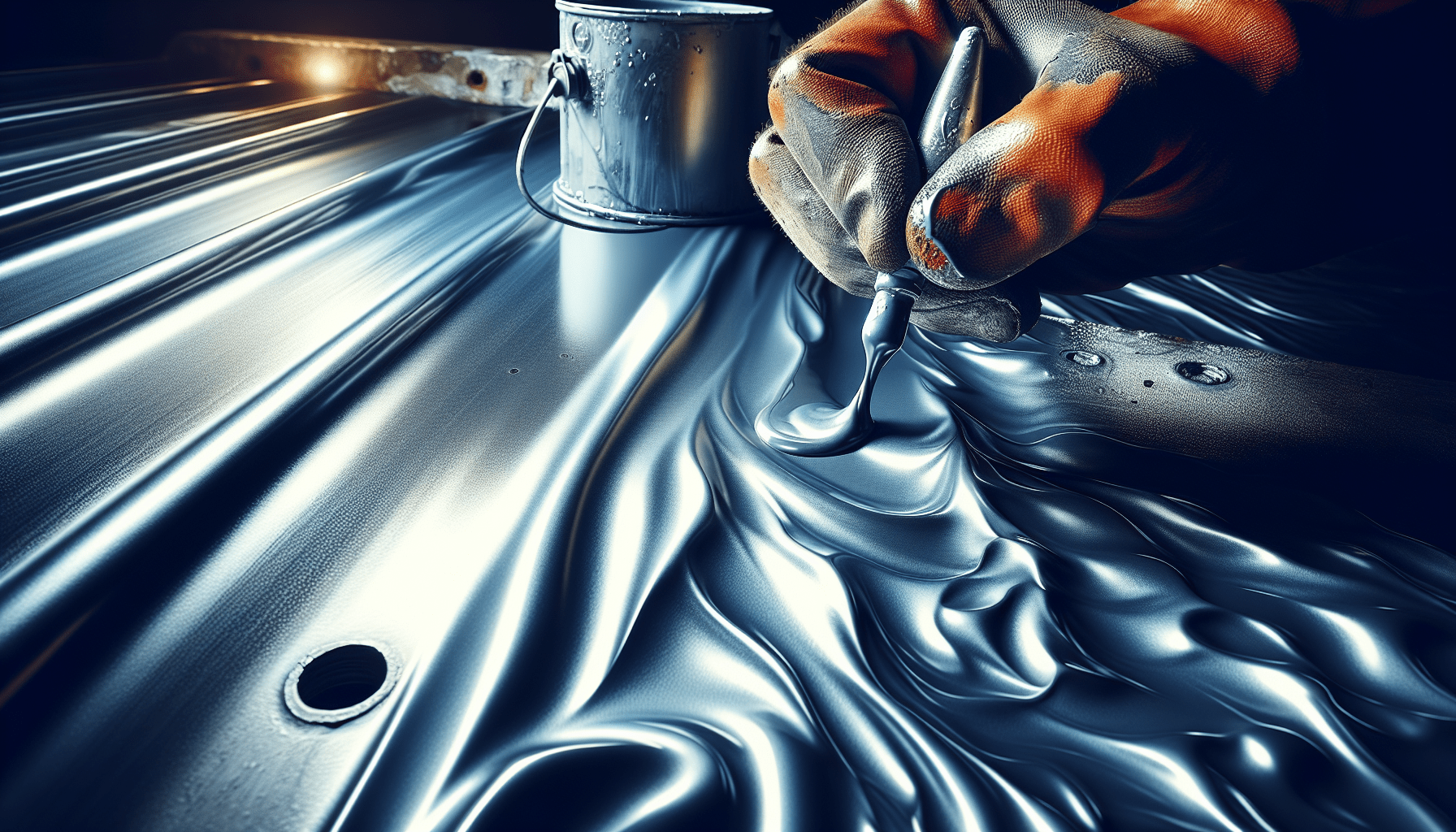Imagine you’ve just finished a day of painting with epoxy, only to realize that your skin is covered in the stubborn, hard-to-remove substance. While it may seem like a daunting task, fear not. In this article, discover a simple yet effective method to safely and efficiently remove epoxy paint from your skin. Say goodbye to the frustration and hello to clean, epoxy-free hands.

Using Warm Water and Soap
When it comes to removing epoxy paint from your skin, one of the easiest and most effective methods is by using warm water and soap. This simple technique can help break down the epoxy paint and make it easier to remove.
Gather supplies
Before you begin, gather all the necessary supplies. You will need a mild soap and warm water. It’s important to use mild soap to avoid any skin irritation or dryness.
Wash the affected area
Start by wetting the affected area with warm water. Then, take a small amount of the mild soap and lather it onto your skin. Gently massage the area in circular motions, ensuring that the soap covers the epoxy paint.
Scrub gently with a soft cloth
After applying the soap, take a soft cloth and gently scrub the area with light pressure. Be careful not to scrub too hard, as this may cause skin irritation or redness. Continue scrubbing until the epoxy paint begins to lift off your skin.
Repeat if necessary
If there are still traces of epoxy paint remaining on your skin, repeat the process by washing the affected area with warm water and soap. This may be necessary for stubborn or larger areas of paint.
Using Vinegar
Another effective method for removing epoxy paint from your skin is by using vinegar. Vinegar is known for its cleaning properties and can help break down the paint.
Prepare the vinegar solution
To prepare the vinegar solution, mix equal parts of vinegar and water in a bowl or container. This will help dilute the vinegar and make it safer to use on your skin.
Apply the solution to the skin
Take a cloth or sponge and soak it in the vinegar solution. Then, gently apply the soaked cloth or sponge to the affected area. Make sure the area is well-saturated with the solution.
Rub gently with a cloth or sponge
Using gentle circular motions, rub the affected area with the cloth or sponge. This will help loosen the epoxy paint from your skin. Be cautious not to apply excessive pressure, as it may cause skin irritation.
Rinse with warm water
Once you have thoroughly rubbed the area, rinse it with warm water. This will help remove the vinegar solution as well as any loosened paint. After rinsing, examine your skin to check if all the paint has been removed. If necessary, repeat the process.
Using Acetone or Nail Polish Remover
Acetone and nail polish remover are commonly used to remove epoxy paint from skin due to their ability to dissolve adhesives. However, it is essential to choose the right product and follow proper safety precautions.
Choose the right product
When using acetone or nail polish remover, make sure it contains pure acetone. Acetone-free nail polish removers may not be as effective in removing epoxy paint. Additionally, ensure you are in a well-ventilated area to avoid inhaling dangerous fumes.
Apply a small amount to a cloth
Pour a small amount of acetone or nail polish remover onto a cloth. It’s important to use a cloth instead of applying the product directly to your skin to prevent excessive drying or irritation.
Rub the affected area
Gently rub the cloth against the epoxy paint on your skin. The acetone or nail polish remover will start dissolving the paint, making it easier to remove. Avoid excessive rubbing or scrubbing, as it may cause skin irritation.
Wash the area with soap and water
After successfully removing the epoxy paint, wash the area with soap and warm water to remove any leftover residue and cleanse your skin. Pat the area dry with a clean towel and apply moisturizer to prevent dryness.
Using Baby Oil or Olive Oil
If you prefer a more natural option, using baby oil or olive oil can also help remove epoxy paint from your skin.
Apply oil to the affected area
Pour a small amount of baby oil or olive oil onto a cotton pad or cloth. Gently apply the oil to the affected area. Make sure the area is well-coated with the oil to effectively break down the paint.
Let the oil sit for a few minutes
Allow the oil to sit on the epoxy paint for a few minutes. This will give it time to penetrate the paint and loosen its grip on your skin.
Gently scrub the area
Using a soft cloth or sponge, gently scrub the affected area in circular motions. The oil will help break down the epoxy paint, making it easier to remove. Ensure you scrub gently to avoid skin irritation.
Rinse with warm water
After scrubbing, rinse the area with warm water to remove the oil and any remaining paint. If some paint still remains, you may need to repeat the process until your skin is clean.

Using Cooking Oil
Cooking oil is another readily available household item that can effectively remove epoxy paint from your skin.
Choose a cooking oil
Select a cooking oil of your choice such as vegetable oil, canola oil, or olive oil. These oils work well to break down the epoxy paint.
Apply the oil to the skin
Pour a small amount of cooking oil onto a cloth or cotton pad. Gently apply the oil to the area with epoxy paint, ensuring it is well-coated. Allow the oil to sit on the paint for a few minutes.
Massage the area gently
Using gentle circular motions, massage the affected area with the oil-coated cloth or pad. The oil will help dissolve the epoxy paint, making it easier to remove. Be careful not to apply too much pressure to avoid skin irritation.
Wash with soap and warm water
Once you have successfully removed the epoxy paint, wash the area with soap and warm water to cleanse the skin thoroughly. This will ensure that any residual oil and paint are removed. Gently pat the area dry with a clean towel.
Using Petroleum Jelly
Petroleum jelly, also known as Vaseline, can be utilized to remove epoxy paint from your skin while providing a protective barrier.
Apply petroleum jelly to the affected skin
Take a small amount of petroleum jelly and apply it directly to the area with epoxy paint. Ensure that the jelly covers the entire affected area.
Let it sit for a few minutes
Allow the petroleum jelly to sit on the epoxy paint for a few minutes. This will help soften the paint and make it easier to remove.
Gently rub the area
Using your fingers or a soft cloth, gently rub the affected area in circular motions. The petroleum jelly will help loosen the epoxy paint from your skin. Be gentle to avoid skin irritation.
Cleanse with warm water and soap
After removing the epoxy paint, cleanse the area with warm water and mild soap. This will help remove any remaining residue and thoroughly clean your skin. Pat the area dry and apply a moisturizer to prevent dryness.
Using Rubbing Alcohol
Rubbing alcohol is known for its ability to dissolve and remove many types of substances, including epoxy paint.
Dampen a cloth with rubbing alcohol
Start by dampening a cloth or cotton pad with rubbing alcohol. Make sure the cloth is not dripping with excess alcohol, as this may irritate your skin.
Gently rub the affected area
Using the damp cloth, gently rub the area with epoxy paint on your skin. The rubbing alcohol will begin to dissolve the paint, making it easier to remove. Avoid excessive rubbing or scrubbing to prevent skin irritation.
Repeat as needed
Depending on the amount of epoxy paint and its adherence to your skin, you may need to repeat the process multiple times. If there are still traces of paint remaining, dampen a fresh cloth with rubbing alcohol and continue to gently rub the area until it is clean.
Wash with soap and water
Once you have successfully removed the epoxy paint, wash the area with soap and warm water to cleanse your skin. This will help remove any residual rubbing alcohol and paint. Pat the area dry with a clean towel.
Using Paint Thinner
Paint thinner can be effective in removing epoxy paint from your skin, but it is essential to exercise caution and ensure proper ventilation.
Use caution and proper ventilation
Before using paint thinner, it is crucial to read and follow the manufacturer’s instructions. Additionally, make sure you are in a well-ventilated area to prevent inhalation of harmful fumes.
Apply a small amount to a cloth
Dampen a cloth with a small amount of paint thinner. Avoid using excessive amounts, as it may damage your skin or cause irritation.
Rub the area gently
Gently rub the cloth against the epoxy paint on your skin. The paint thinner will start dissolving the paint, making it easier to remove. Be careful not to apply excessive pressure or scrub too hard to prevent skin irritation.
Cleanse with soap and water
After successfully removing the epoxy paint, wash the area with soap and warm water to remove any residue or paint thinner. This will ensure your skin is thoroughly cleansed. Pat the skin dry with a clean towel.
Using Baking Soda and Water
Baking soda is a versatile household item that can help remove epoxy paint from your skin when combined with water.
Create a paste with baking soda and water
In a small bowl, mix baking soda and water to create a paste. The consistency should be thick enough to adhere to your skin. Adjust the ratio of baking soda to water as needed.
Apply the paste to the epoxy paint
Take a small amount of the baking soda paste and apply it to the area with epoxy paint. Make sure the paste covers the entire affected area.
Gently scrub the area
Using your fingers or a soft cloth, gently scrub the area in circular motions. The baking soda paste will act as an abrasive, helping to remove the epoxy paint. Be cautious not to scrub too hard to avoid skin irritation.
Rinse with warm water
After scrubbing, rinse the area with warm water to remove the baking soda paste and any loosened paint. If some paint remains, repeat the process until your skin is clean.
Using Lemon Juice or Citrus-based Cleaner
Lemon juice, known for its acidic properties, or a citrus-based cleaner can effectively remove epoxy paint from your skin.
Squeeze fresh lemon juice or obtain citrus-based cleaner
If using lemon juice, squeeze fresh lemon juice into a small container. If using a citrus-based cleaner, ensure it is safe for use on skin by checking the label.
Apply the lemon juice or cleaner to the skin
Take a cloth or cotton pad and soak it in the lemon juice or citrus-based cleaner. Gently apply the soaked cloth or pad to the affected area. Ensure the area is well-saturated.
Gently scrub the area
Using circular motions, gently scrub the affected area with the cloth or pad. The acidic properties of the lemon juice or citrus-based cleaner will help break down the epoxy paint. Be careful not to apply excessive pressure, as it may irritate the skin.
Rinse with warm water
After scrubbing, rinse the area with warm water to remove the lemon juice or citrus-based cleaner, as well as any loosened paint. Check your skin to ensure all the paint has been removed. Repeat the process if necessary.
In conclusion, epoxy paint can be a tough substance to remove from your skin. However, with the right techniques and supplies, it is possible to effectively remove epoxy paint and restore your skin’s cleanliness. Whether you choose to use warm water and soap, vinegar, acetone, baby oil, cooking oil, petroleum jelly, rubbing alcohol, paint thinner, baking soda paste, or lemon juice, it is essential to follow the recommended steps and exercise caution to avoid skin irritation or damage. Stay prepared with the necessary supplies and be patient in the process, as multiple attempts may be required for a complete removal. By taking the appropriate measures, you can safely and successfully remove epoxy paint from your skin.



